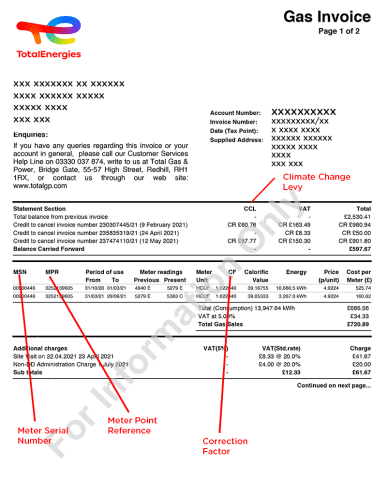How to Read Your Business Energy Invoice/Bill
How to read your business gas invoice
- To calculate the gas used, subtract the previous read from the present for each meter.
- Multiply the figure by the Correction Factor (CF).
- To calculate the number of M3 used, multiply this figure by the Conversion Factor (shown below in the table and on the reverse of your invoice). Please ignore this part of the calculation if your meter is already measured in M3.
- Multiply this figure by the Calorific Value (CV).
- Divide this figure by 3.6 to convert to kWh.
- Multiply the number of kWh by the unit price to calculate the cost per meter.
- Add together the cost of each meter to calculate the total cost, excluding VAT.
- VAT is added at 20% unless any exemptions apply.
- Apply CCL at the current rate, found here unless any reductions apply.
- The sum of these calculations amounts to the total gas sale.
Meter Unit Conversion Factor
|
MCUF |
Thousands of Cubic Feet |
28.317 |
|---|---|---|
|
HCUF |
Hundreds of Cubic Feet |
2.8317 |
|
TCUF |
Tens of Cubic Feet |
0.28317 |
|
OCUF |
One Cubic Foot |
0.028317 |
|
HM3 |
Hundreds of Cubic Metres |
100 |
|
TM3 |
Tens of Cubic Metres |
10 |
|
NM3 |
Tenths of Cubic Metres |
0.1 |

How to read your business electricity invoice
How to calculate your non-half-hourly electricity invoice
- To calculate the number of billed units (electricity consumed), deduct the present meter read from the previous one.
- Multiply the billed units by their respective price.
- Non-half hourly meters may have several different readings. The time periods and prices these refer to are stated in your contract.
These meter readings may be actual, customer or estimate as indicated on your invoice. - The total (consumption) is the consumption for all readings for the period of use. The total cost associated with the total consumption is also stated.
- Multiply the billed units of Standing Charge by price (if applicable).
- Multiply the billed units of Capacity Charge by price (if applicable).
- Add together Capacity Charge and Standing Charge to get the total other charges.
- Apply CCL at the current rate, found here unless any reductions apply.
- VAT applied at 20.0% unless exemptions apply.
- The sum of these calculations amounts to the total electricity sale.
How to calculate your half-hourly electricity invoice
- Billed units are calculated for the period of use, and they are measured in kWh.
- These units are then multiplied by their respective prices.
- Half-hourly meters may have up to six consumption periods. The time periods and prices these refer to are stated in your contract.
- The total (consumption) is the consumption for all consumption periods for the period of use. The total cost associated with the total consumption is also stated.
- Multiply the billed units of Standing Charge by Price (if applicable).
- Multiply the billed units of Capacity Charge by Price (if applicable).
- Add together Capacity Charge and Standing Charge to get total other charges (if applicable). Please note that there may be charges specific to your individual contract.
- Apply CCL at the current rate, found here unless any reductions apply.
- VAT is added at 20.0% unless any exemptions apply.
- The sum of these calculations amounts to the total electricity sale.

Invoice Definitions
|
A |
A after a meter reading indicates actual read taken by the data collector or agents working on its behalf |
|---|---|
|
E |
E after a meter reading indicates an estimated read |
|
C |
C after a meter reading indicates a read given by the customer |
|
S |
S after a meter reading indicates a read that has been agreed between two gas or electricity companies when the supply has transferred from one to the other |
|
Kilowatt Hours (kWh) |
This is the unit of measure for energy consumed |
|
Climate Change Levy (CCL) |
This is a government energy tax on Industrial and Commercial consumption, subject to VAT To calculate CCL multiply Total Consumption by the rate assigned to gas or electricity (reductions may be applicable) |
|
Meter Point Reference (MPR) |
A unique number that identifies the specific point of entry of the gas supply into the property |
|
Correction Factor (CF) |
A fixed meter specific factor applied to take into account the effect of temperature and pressure on actual gas flow. It is a legal requirement to include this factor in the calculation of our invoices. |
|
Calorific Value (CV) |
This represents the amount of heat or energy in a given volume of gas. An average calorific value is calculated monthly by the transporter and allows for any periodic or regional variations in the quality of natural gas. It is a legal requirement that we include this factor in the calculation of our invoices |
